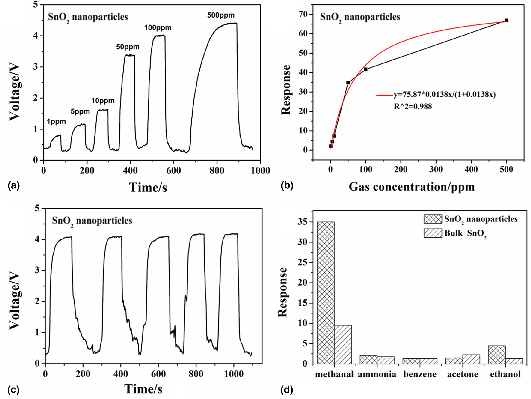Crossref Citations
This article has been cited by the following publications. This list is generated based on data provided by
Crossref.
Zheng, Jiaoling
Hou, Huanhuan
Fu, Hao
Gao, Liping
and
Liu, Hongjie
2021.
Size-controlled synthesis of porous ZnSnO3 nanocubes for improving formaldehyde gas sensitivity.
RSC Advances,
Vol. 11,
Issue. 33,
p.
20268.
Zhang, Gaoqi
Zhang, Fan
Wang, Kaifang
Liu, Shanyu
Wang, Ying
Zhong, Bo
Bai, Hubin
Yin, Jun
Zhang, Hangbin
and
Cong, Lin
2021.
Enhanced Gas Sensing of Tin Dioxide Based Sensor for Indoor Formaldehyde Application.
Journal of Nanoelectronics and Optoelectronics,
Vol. 16,
Issue. 2,
p.
337.
Chattopadhyay, Anamitra
and
Nayak, Jhasaketan
2021.
Enhanced room temperature sensitivity of undoped HfO2 nanoparticles towards formaldehyde gas.
Applied Physics A,
Vol. 127,
Issue. 12,
Shihabudeen, P. K.
and
Roy Chaudhuri, Ayan
2021.
Ethanol sensing properties of nitrogen doped In2O3 thin films.
Journal of Materials Research,
Vol. 36,
Issue. 7,
p.
1561.
Hachoun, Zoubir
Ouerdane, Abdallah
Yahiaoui, Ibrahim
Gulakhmadov, Aminjon
and
Chen, Xi
2021.
RETRACTED ARTICLE: Investigating the sensing properties of SnO2 nanoparticles doped with gold.
Applied Physics A,
Vol. 127,
Issue. 7,
Ma, Xin
Ying, Zhihua
Wen, Fei
Li, Lili
Zheng, Xiaolong
Zheng, Peng
and
Wang, Gaofeng
2022.
Gas-Sensitive Properties of ZnO/ZnCo2O4 Made from Sodium Citrate Against Formaldehyde.
Journal of Electronic Materials,
Vol. 51,
Issue. 12,
p.
7009.
Chattopadhyay, Anamitra
and
Nayak, Jhasaketan
2022.
Hafnium oxide nanoparticles synthesized via sol-gel route for an efficient detection of volatile organic compounds at room temperature.
Materials Science in Semiconductor Processing,
Vol. 139,
Issue. ,
p.
106336.
Liu, Jianqiao
Lv, Jiarong
Xiong, Haomiao
Wang, Yujia
Jin, Guohua
Zhai, Zhaoxia
Fu, Ce
and
Zhang, Qianru
2022.
Size effect and comprehensive mathematical model for gas-sensing mechanism of SnO2 thin film gas sensors.
Journal of Alloys and Compounds,
Vol. 898,
Issue. ,
p.
162875.
Mohammad Yusof, Nabilah
Ibrahim, Suriani
and
Rozali, Shaifulazuar
2022.
Advances on graphene-based gas sensors for acetone detection based on its physical and chemical attributes.
Journal of Materials Research,
Vol. 37,
Issue. 2,
p.
405.
Chaitra, C
Kalpana, H.M.
Ananda, C.M.
and
Lalithamba, H.S.
2022.
Green synthesis of tin oxide based nanoparticles using Terminalia bellirica seed extract: impact of operating temperature and antimony dopant on sensitivity for carbon dioxide gas sensing application.
Materials Technology,
Vol. 37,
Issue. 12,
p.
2339.
Li, Ziteng
Zeng, Wen
and
Li, Qingting
2022.
SnO2 as a gas sensor in detection of volatile organic compounds: A review.
Sensors and Actuators A: Physical,
Vol. 346,
Issue. ,
p.
113845.
Xiang, Chao
Chen, Tingting
Zhao, Yan
Sun, Jianhai
Jiang, Kaisheng
Li, Yongzhen
Zhu, Xiaofeng
Zhang, Xinxiao
Zhang, Ning
and
Guo, Ruihua
2022.
Facile Hydrothermal Synthesis of SnO2 Nanoflowers for Low-Concentration Formaldehyde Detection.
Nanomaterials,
Vol. 12,
Issue. 13,
p.
2133.
Li, Weichao
Zhou, Liexing
Xie, Linkun
Kang, Kunyong
Xu, Juan
and
Chai, Xijuan
2022.
N-Fe-Gd co-doped TiO2/g-C3N4 nanosheet hybrid composites with superior photocatalytic dye degradation.
Advanced Composites and Hybrid Materials,
Vol. 5,
Issue. 1,
p.
481.
Ma, Dianpu
Zhang, Lang
Hu, Juntao
Fu, Zewei
Luo, Tan
Yang, Di
Fang, Dong
Li, Jun
Peng, Jubo
and
Wang, Yingwu
2022.
Preparation and gas-sensitive properties of hollow Zn2SnO4/SnO2 nano-cubes.
Inorganic Chemistry Communications,
Vol. 141,
Issue. ,
p.
109507.
Li, Jin
Xian, Jianbiao
Wang, Wanjing
Cheng, Kai
Zeng, Min
Zhang, Aihua
Wu, Sujuan
Gao, Xingsen
Lu, Xubing
and
Liu, Jun-Ming
2022.
Ultrafast response and high-sensitivity acetone gas sensor based on porous hollow Ru-doped SnO2 nanotubes.
Sensors and Actuators B: Chemical,
Vol. 352,
Issue. ,
p.
131061.
Das, Tanushri
Mojumder, Subhajit
Chakraborty, Sonam
Saha, Debdulal
and
Pal, Mrinal
2022.
Beneficial effect of Sn doping on bismuth ferrite nanoparticle-based sensor for enhanced and highly selective detection of trace formaldehyde.
Applied Surface Science,
Vol. 602,
Issue. ,
p.
154340.
Xu, Jingzheng
Zhang, Hanzhuo
Fu, Zhimin
and
Ling, Yihan
2022.
Hydrothermal synthesis of hierarchical CuBi2O4 microspheres with improved gas sensitivity.
Ceramics International,
Vol. 48,
Issue. 21,
p.
31519.
Kumar, Mohit
Mohajir, Achraf EL
Berger, Franck
Raschetti, Marina
and
Sanchez, Jean-Baptiste
2022.
Dealuminated Zeolite Y/SnO2 Nanoparticle Hybrid Sensors for Detecting Trace Levels of Propanol as a Lung Cancer Biomarker.
ACS Applied Nano Materials,
Vol. 5,
Issue. 7,
p.
9170.
Ma, Xiangbo
Gao, Rui
Zhang, Tao
Sun, Xuemei
Li, Ting
shan, gao
Zhang, Xianfa
Xu, yingming
Cheng, Xiaoli
and
Huo, Li-Hua
2022.
Mesoporous Sno2 Nanospheres Sensor for Fast Detection of Hcho and its Application in Safety Detection of Aquatic Products.
SSRN Electronic Journal ,
Guo, Lanlan
Wang, Yuanyuan
Zeng, Hua
Feng, Yanji
Yang, Xueli
Zhang, Saisai
Xu, Yonghao
Wang, Guodong
Wang, Yan
and
Zhang, Zhanying
2022.
Rational Design of SnO2 Hollow Microspheres Functionalized with Derivatives of Pt Loaded MOFs for Superior Formaldehyde Detection.
Nanomaterials,
Vol. 12,
Issue. 11,
p.
1881.






